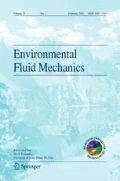Abstract
Aquaculture structures are responsible for flow disturbances that extend over a large range of scales. In the case of shellfish aquaculture, those scales extend from the size of an individual shellfish to the size of a whole farm with intermediate scales being the size of a shellfish structure or of a block of shellfish structures. The influence of block spacing and angle is investigated by the mean of a 2D high resolution computational fluid dynamics model. Block angle is found to be the main relevant parameter controlling to a large extent the mixing generated by the shellfish structures. Strong sensitivity is found for small angles. Nevertheless, it is shown that for a limited number of blocks, upstream turbulence still dominates the degree of the total mixing within the farm, and that total flow reduction is little affected by the orientation of the blocks. A simple analytical model is presented that predicts most of the numerical results.
Similar content being viewed by others
References
Blanco J, Zapata M, Morono A (1996) Some aspects of the water flow through mussel rafts. Scientia Marina 60(2–3): 275–282
Boyd AJ, Heasman KG (1998) Shellfish mariculture in the benguela system: water flow patterns within a mussel farm in Saldanha Bay, South Africa. J Shell Res 17(1): 25–32
Cromey CJ, Nickell TD, Black KD (2002) Depomod—modelling the deposition and biological effects of waste solids from marine cage farms. Aquaculture 214: 211–239
Dudley RW, Panchang VG, Newell CR (2000) Application of a comprehensive modeling strategy for the management of net-pen aquaculture waste transport. Aquaculture 187(3–4): 319–349
Giles H, Pilditch CA (2004) Effects of diet on sinking rates and erosion thresholds of mussel perna canaliculus biodeposits. Marine Ecol Prog Ser 282: 205–219
Grant J, Bacher C (2001) A numerical model of flow modification induced by suspended aquaculture in a Chinese bay. Can J Fish Aquat Sci 58: 1003–1011
Grant J, Bacher C, Cranford PJ, Guyondet T, Carreau M (2008) A spatially explicit ecosystem model of seston depletion in dense mussel culture. J Marime Syst 73(1–2): 155–168
Hartstein ND, Stevens CL (2005) Deposition beneath long-line mussel farms. Aqua Eng 33: 192–213
Jackson GA, Winant CD (1983) Effect of a kelp forest on coastal currents. Contin Shelf Res 2: 75–80
Koller J, Koppel J, Petters W (2006) Offshore wind energy—research on environmental impacts. Springer, Berlin
Lesieur M, Metais O (1996) New trends in large-eddy simulation of turbulence. Ann Rev Fluid Mech 28: 45–82
Nepf H, Koch E (1999) Vertical secondary flows in submersed plant-like arrays. Limnol Oceano 44(4): 1072–1080
Panchang VG, Cheng G, Newell CR (1997) Modeling hydrodynamics and aquaculture waste transport in coastal maine. Estuar Coasts 20(1): 14–41
Plew D, Stevens CL, Spigel RH, Hartstein ND (2005) Hydrodynamic implications of large offshore mussel farms. IEEE J Ocean Eng 30(1): 95–108
Pilditch CA, Grant J, Bryan KR (2001) Seston supply to sea scallops (placopecten magellanicus) in suspended culture. Can J Fish Aquat Sci 58: 241–253
Plew DR (2005) The hydrodynamic effects of long-line mussel farms. PhD Thesis, Department of Civil Engineering, University of Canterbury. digital-library.canterbury.ac.nz/data/collection3/etd/adt%2DNZCU20060106.144622
Plew DR (2009) Drag coefficients for modelling flow through suspended canopies. J Marine Ecol (submitted)
Plew DR, Enright MP, Nokes RI, Dumas JK (2009) Effect of mussel bio-pumping on the drag on and flow around a mussel crop rope. Aqua Eng 40: 51–61
Popinet S (2003) Gerris: a tree-based adaptive solver for the incompressible Euler equations in complex geometries. J Comput Phys 190: 572–600
Popinet S, Smith M, Stevens CL (2004) Experimental and numerical study of the turbulence characteristics of air flow around a research vessel. J Ocean Atmos Technol 21(10): 1574–1589
Rosman JH, Koseff JR, Monismith SG (2007) A field investigation into the effects of a kelp forest (macrocystis pyfera) on coastal hydrodynamics and transport. J Geophy Res 112: CO2016
Seymour RJ, Hanes DM (1979) Performance analysis of tethered float breakwaters. J Waterway Port Coast Ocean Eng 105(3): 265–280
Stevens C, Smith M, Gorman R, Popinet S, Walters R (2007) Marine renewable energy research in New Zealand: a multi-scale perspective of resources and impacts. In: Australian coasts and ports conference, Melbourne, Australia
Stevens CL (2003) Turbulence in an estuarine embayment: observations from Beatrix Bay, New Zealand. J Geophys Res 108. doi:10.1029/2001JC001221
Stevens CL, Plew D, Hartstein N, Fredriksson D (2008) The physics of open-water shellfish aquaculture. Aqua Eng 38(3): 145–160
Author information
Authors and Affiliations
Corresponding author
Rights and permissions
About this article
Cite this article
Delaux, S., Stevens, C.L. & Popinet, S. High-resolution computational fluid dynamics modelling of suspended shellfish structures. Environ Fluid Mech 11, 405–425 (2011). https://doi.org/10.1007/s10652-010-9183-y
Received:
Accepted:
Published:
Issue Date:
DOI: https://doi.org/10.1007/s10652-010-9183-y




